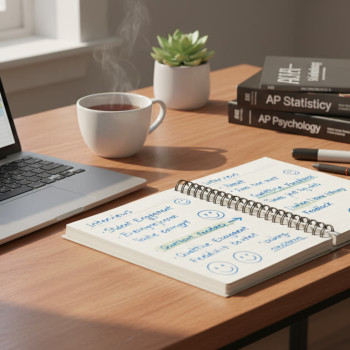Introduction: Two Systems, One Goal — Clear, Persuasive Writing
For students navigating the academic world across curricula — especially those moving between CBSE English Core and the College Board’s AP English Language and Composition — the expectations can feel like different languages at first glance. But step back and you’ll see an encouraging truth: both systems celebrate the same central skill set — clarity of thought, effective argumentation, strong textual evidence, and the ability to write for purpose and audience.
This blog walks you and your parents through the similarities and differences in writing expectations between CBSE English Core and AP Lang, with practical examples, a clear comparison table, and study strategies. You’ll come away with a toolkit to adapt your skills confidently — whether you’re preparing for board exams, aiming for a strong AP score, or strengthening college-ready writing.
Why Compare CBSE English Core and AP Lang?
CBSE English Core provides a strong foundation in literature, language, and structured writing tasks. AP Lang builds on such foundations but emphasizes rhetorical analysis, synthesis, and college-level argumentative writing under timed conditions. Understanding how they align helps students:
- Spot transferable skills (like thesis crafting and evidence use).
- Fill in targeted gaps (such as rhetorical analysis practice or timed synthesis essays).
- Build exam strategies that work across systems.

Core Writing Expectations: Side-by-Side
Let’s start by mapping the high-level expectations. The table below summarizes practical skills students are expected to display in CBSE English Core versus AP Lang writing tasks.
| Skill or Expectation | CBSE English Core | AP English Language |
|---|---|---|
| Purpose and Audience | Focus on clarity, formal tone, and adherence to prescribed formats (letters, essays, reports). | Strong emphasis on tailoring tone and strategy to specific audiences; rhetorical purpose is central. |
| Thesis and Central Claim | Clear thesis is expected in essays; often guided by question prompts. | Concise, defensible thesis is crucial — often must be established quickly in timed conditions. |
| Organization | Structured paragraphs with topic sentences; linear progression is rewarded. | Logical structure is vital; cohesive devices and rhetorical sequencing are carefully assessed. |
| Evidence and Examples | Use of textual examples and general knowledge; direct references to set texts. | Frequent need to synthesize multiple sources, or perform close rhetorical readings of passages. |
| Language and Style | Emphasis on correctness, vocabulary, and idiomatic expression. | Range of diction is valued, along with stylistic choices to persuade or analyze — voice matters. |
| Critical Thinking | Interpretation and evaluation of themes and ideas in literature and language tasks. | Analytical rigor in assessing argument, rhetorical strategies, and constructing syntheses. |
| Time-Constrained Writing | Typically longer preparation for school exams and assignments. | Timed essays are central — planning and execution under strict time limits is key. |
Where Students Usually Excel — and Where They Need to Stretch
Strengths from CBSE That Transfer Well
CBSE students often enter AP Lang with several advantages:
- Comfort with formal registers and polished grammar.
- Practice with structured essays and literary analysis from prescribed texts.
- Familiarity with building a clear introduction, body paragraphs, and conclusion.
Common Gaps to Address
To meet AP Lang expectations, CBSE students may need targeted practice in a few areas:
- Rhetorical analysis of non-literary texts (speeches, op-eds, visuals).
- Synthesis of multiple sources into a single coherent argument under time pressure.
- Concise thesis statements that also guide sophisticated analysis.
- Strategic use of rhetorical devices and an explicit vocabulary for discussing them (ethos, pathos, logos, tone, diction, syntax).
Practical Strategies to Bridge the Gap
Below are concrete steps you can apply in daily study sessions. These strategies are actionable, stageable, and designed to respect the demands of both curricula.
1. Make Rhetorical Reading a Habit
Practice reading a short non-literary passage daily (an editorial, a speech excerpt, or a well-written blog post). Track:
- The author’s purpose (inform, persuade, critique).
- Audience and tone.
- Two rhetorical strategies the author uses and how they support the purpose.
Spend 10–15 minutes making a quick annotation and then write a 100–150 word summary that highlights rhetorical moves rather than plot or surface meaning.
2. Tighten Thesis Crafting
Work on thesis templates that move beyond “X is good because…” Try: “Although X acknowledges Y, the author ultimately argues Z through strategies A and B, which [effect on audience].” Aim to write and revise a thesis in one or two minutes — this skill is invaluable in timed AP tasks.
3. Build a Rhetorical Toolbox (and Use It)
Make a one-page cheat sheet listing rhetorical devices and a short example of each. Practice incorporating these labels in short analysis paragraphs: don’t just say a writer uses emotion — name it, show an example, and explain its effect.
4. Practice Synthesis by Stitching Sources
Take short articles with different viewpoints on the same topic. Create a plan for a 30-minute synthesis essay: develop a thesis that weaves the sources together, decide which three sources will form your body paragraphs, and note the specific evidence you’ll use from each.
5. Simulate Timed Conditions Regularly
AP exam conditions reward quick planning and clear execution. Start with relaxed timed practice (50 minutes for an essay), then step down (40 minutes, 30 minutes) to build speed and clarity. Each simulation should end with a quick self-assessment: strengths, one change, and one specific next step.
Sample Task and Walkthrough
Here’s a condensed example to show how a CBSE-trained writer can approach a typical AP Lang prompt.
Prompt (paraphrased)
Read a short editorial arguing that social media harms political discourse. Write an essay analyzing how the author uses rhetorical strategies to build the argument.
Step-by-Step Walkthrough
- Minute 1–3: Read the passage for tone and main claim. Underline strong claims and persuasive techniques.
- Minute 3–5: Draft a thesis: name the author’s claim and the two or three central rhetorical strategies.
- Minute 5–25: Build two or three body paragraphs. Each paragraph: topic sentence, brief example from passage, explanation of the device, and a sentence about the effect on the audience.
- Minute 25–45: Write a concise introduction and conclusion that restates the claim and connects strategies to overall effectiveness.
- Minute 45–50: Quick proofreading for grammatical errors and clarity.
This framework will feel familiar to CBSE students because it uses structured paragraphs and textual evidence; the main adjustment is the sharper focus on rhetorical function and audience effect.

Checklist: What AP Readers Look For
When AP graders evaluate essays, they are looking for a few clear signs of effectiveness. Keep this checklist handy during practice.
- Clear and defensible thesis.
- Coherent organization and controlled pacing.
- Specific, relevant evidence from the text(s).
- Explanation of how evidence supports claims — don’t just quote, interpret.
- Command of language, varied sentence structure, and appropriate register.
- An awareness of audience and rhetorical effects.
How to Use CBSE Assignments to Train for AP Lang
You don’t need to throw out CBSE study habits; instead, retool them slightly.
- Turn a CBSE literary analysis into a rhetorical analysis by focusing on how authors persuade readers rather than only what themes appear.
- When writing letters or essays for CBSE, practice adopting different audiences (a principal, the public, a policymaker) and vary your tone and supporting evidence accordingly.
- For summary and précis exercises, add a sentence evaluating the rhetorical effectiveness of the original — who benefits from the style chosen?
Parent Guide: How to Support Your Child
Parents can be powerful allies in the transition from CBSE to AP-style writing. Here’s how to help without doing the work for them.
- Create a quiet, distraction-free environment for timed practice.
- Be a sounding board — ask your child to explain their thesis aloud before they write; forcing an oral articulation often clarifies the written claim.
- Encourage consistent, short daily habits (15–30 minutes) rather than infrequent marathon sessions.
- Celebrate iterations: improvement shows up in drafts and revisions, not just final scores.
Real-World Context: Why These Skills Matter Beyond Tests
Mastering the skills valued by AP Lang is not just about earning a higher score — it’s about becoming a persuasive communicator in academic, civic, and professional contexts. Whether you’re writing an application essay, arguing a position in a classroom debate, or evaluating sources for research, the ability to read rhetorically and write with purpose serves you for life.
Example Rubric: Quick Self-Assessment
Use this short rubric to rate your practice essays. Score each area from 1 (needs work) to 5 (strong).
| Criterion | 1 | 2 | 3 | 4 | 5 |
|---|---|---|---|---|---|
| Thesis Clarity | Unclear or missing | Weak or too broad | Acceptable but unrefined | Clear and focused | Concise, insightful, guiding |
| Use of Evidence | No evidence or irrelevant | Limited or weak evidence | Relevant but under-explained | Well-chosen and explained | Compelling and integrated |
| Analysis Depth | Superficial | Basic explanation | Shows good insight | Thoughtful and deep | Nuanced and original |
| Organization and Flow | Disorganized | Some structure | Mostly logical | Clear transitions | Elegant, persuasive flow |
| Language and Mechanics | Many errors | Frequent errors | Some errors | Minor errors | Polished, precise |
How Personalized Support Helps — The Role of Targeted Tutoring
Many students benefit from tailored feedback during this transition. Personalized tutoring — for example, one-on-one guidance that creates tailored study plans, expert tutors who model rhetorical analysis, and AI-driven insights that pinpoint recurring weak spots — can accelerate progress. A focused tutor can:
- Help refine thesis statements and paragraph structure in real time.
- Provide targeted practice prompts that mirror AP timing and scoring.
- Offer iterative feedback so students can see tangible improvement across drafts.
If you choose a tutoring option, look for programs that combine human expertise with smart diagnostics so practice time is efficient and personalized.
Putting It All Together: A 6-Week Transition Plan
This plan assumes you already have a foundation in CBSE English Core. It’s paced to build confident, AP-ready skills in about six weeks.
- Week 1 — Rhetorical Awareness: Daily short readings and annotations; create your rhetorical toolbox.
- Week 2 — Thesis and Structure: Practice concise thesis writing; outline essays without writing full drafts.
- Week 3 — Evidence and Analysis: Turn CBSE text-based essays into rhetorical analyses; focus on explanation over summary.
- Week 4 — Synthesis Practice: Introduce multi-source tasks; plan and write one synthesis per week.
- Week 5 — Timed Writing: Begin 40–50 minute timed prompts twice weekly with focused review.
- Week 6 — Polishing and Feedback: Full mock exam under timed conditions; targeted tutoring or teacher feedback to refine weak points.
Final Tips: Habits That Build Confidence
- Read widely — editorials, speeches, and high-quality essays teach rhetorical moves naturally.
- Write regularly, even in small doses. Daily journaling about readings builds speed and clarity.
- Seek feedback early and often. One-on-one tutoring or teacher reviews help you iterate faster than solo practice.
- Practice metacognition: after each essay, write a 3-sentence reflection on the biggest improvement and the next target.
Closing Thoughts
CBSE English Core and AP English Language are different in design, but their shared aim is to produce thoughtful, clear, and persuasive communicators. If you’re a student moving between these systems, celebrate how much you already know — structured essays, command of grammar, and literary sensitivity are real assets. With targeted practice in rhetorical reading, thesis precision, synthesis, and timed writing, you’ll adapt quickly and confidently.
Finally, remember that progress is gradual and measurable. Personalized tutoring — offering 1-on-1 guidance, tailored study plans, expert tutors, and AI-driven insights — can be especially helpful for students who want focused feedback and efficient growth. Use your strengths, address the gaps with intention, and enjoy the process of becoming a sharper, more persuasive writer.
Ready to Begin?
Start with one short rhetorical reading today and write a 150-word analysis. Keep it simple: identify the author’s purpose, two strategies, and one sentence on effect. Small daily habits add up quickly. Good luck — you’ve got this.


















No Comments
Leave a comment Cancel